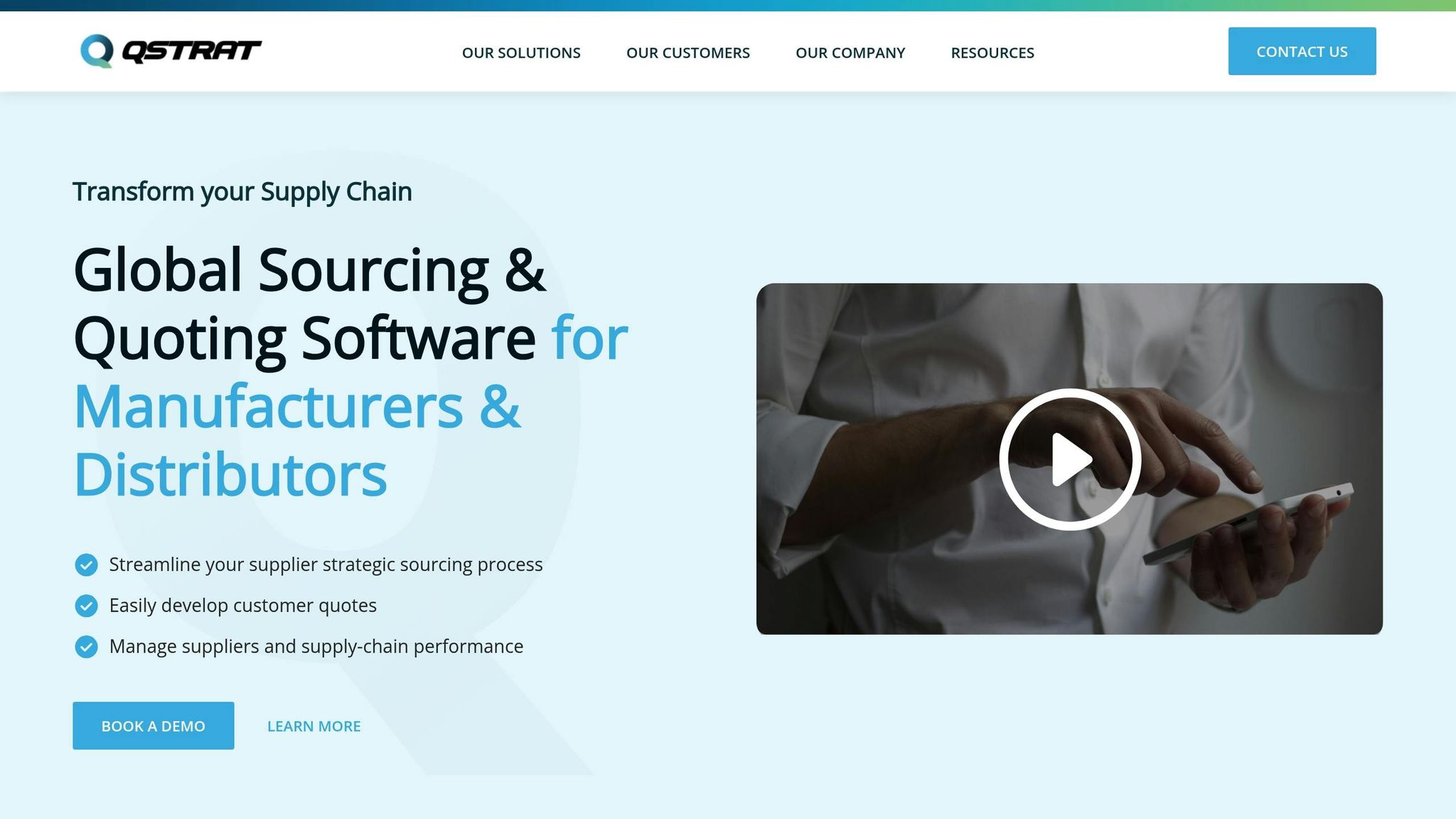
Supplier risk management is all about identifying, assessing, and reducing risks in your supply chain to keep operations running smoothly. Whether it’s financial instability, compliance failures, or cybersecurity threats, managing supplier risks is critical for avoiding costly disruptions. Here’s what you need to know:
- Why it matters: Supply chain disruptions cost U.S. manufacturers an average of $184M per incident. Industries like automotive and medical devices are especially vulnerable due to complex global networks.
- Key risk types: Financial instability, operational delays, compliance issues, cybersecurity vulnerabilities, and ESG concerns.
- How to manage risks:
- Map your supply chain to identify weak points.
- Use tools like supplier scorecards, risk matrices, and automated systems for real-time monitoring.
- Diversify suppliers and develop backup plans.
- Build strong relationships with suppliers through clear communication and collaboration.
- Leverage frameworks like NIST and ISO for structured risk management.
Quick Tip: Cloud-based platforms like QSTRAT can streamline risk management by automating data collection, tracking supplier performance, and integrating with ERP/CRM systems for better visibility.
How to Identify and Assess Supplier Risks
Steps to Identify Supplier Risks
Managing supplier risks effectively starts with creating a detailed map of your supply chain. This includes pinpointing geographic locations, tracking product flows, and understanding logistics networks. The goal? To uncover weak links or single points of failure that could disrupt operations.
A great example of this approach comes from Carl Zeiss. They use QSTRAT Sourcing to gather over 50 data points from qualified suppliers during the bidding process. This data not only informs decisions but also leads to further actions like trials and full-scale production.
Once your supply chain is mapped, it’s time to evaluate supplier criticality. Focus on single-source suppliers or those providing strategic components. These are the areas where risk assessment and resource allocation should be prioritized.
To dig deeper, collect data on various factors like financial health, past performance, certifications, ESG (Environmental, Social, and Governance) scores, and cybersecurity standards. Tools like supplier questionnaires, third-party databases, news tracking, and audits are invaluable for this process.
Collaboration across departments is essential. Procurement, risk management, IT, legal, and compliance teams should work together to ensure no risk area is overlooked. With risks identified, the next step is defining clear and measurable criteria to assess them.
Setting Risk Criteria
Defining risk criteria is all about aligning them with your organization’s risk tolerance and industry standards. These criteria should be specific and measurable.
For financial stability, look at metrics like credit scores, liquidity ratios, debt-to-equity ratios, and cash flow. These indicators help determine whether a supplier can weather economic challenges or unexpected disruptions.
When it comes to quality, focus on metrics like defect rates, return percentages, on-time delivery, and customer satisfaction. For instance, BAE Systems uses QSTRAT Sourcing not just to compare costs but also to drive improvements in quality.
"For BAE, QSTRAT Sourcing is much more than a great tool to compare price, labor, raw material, packaging, and transportation among our suppliers. It’s helping BAE become a better manufacturer by using QSTRAT Sourcing as a learning tool for suppliers. Through this process we are driving our quality initiatives forward." – BAE Systems
Compliance is another critical area, especially in regulated industries like aerospace, medical devices, and automotive. Here, certifications, audit results, and adherence to industry standards are key measures, as non-compliance can carry heavy penalties.
ESG factors are gaining importance due to regulatory and consumer demands. Evaluate suppliers on aspects like their carbon footprint, labor practices, ethical sourcing, and governance structures.
| Risk Category | Key Metrics | Assessment Methods |
|---|---|---|
| Financial Health | Credit scores, liquidity ratios, cash flow | Financial audits, credit reports, third-party ratings |
| Quality Standards | Defect rates, on-time delivery, returns | Performance scorecards, customer feedback, audits |
| Compliance | Certifications, audit results, violations | Regulatory checks, compliance audits, document reviews |
| ESG Factors | Carbon footprint, labor practices, governance | ESG assessments, site visits, third-party evaluations |
Risk Assessment Tools and Methods
Once you’ve quantified risks, structured tools can help you monitor and prioritize them effectively.
- Supplier scorecards: Assign numerical ratings based on factors like financial health and delivery performance.
- Risk matrices: Plot risks by likelihood and impact severity to identify which ones need immediate attention.
- Automated systems: Use these to analyze large volumes of data from multiple sources. They provide real-time updates and flag potential issues that might go unnoticed in manual reviews.
- Supplier audits: Conducted internally or by third parties, these provide detailed insights into supplier operations, compliance, and risk exposure. Tailor the frequency and depth of audits based on the supplier’s risk profile.
- Scenario modeling: A proactive approach that tests how suppliers might perform under stress, such as economic downturns, natural disasters, or regulatory changes. This helps uncover vulnerabilities before they escalate.
Segmenting suppliers by risk level ensures efficient resource allocation. High-risk suppliers require closer attention and frequent reviews, while low-risk suppliers can be monitored less intensively.
Modern cloud-based platforms like QSTRAT simplify the process by automating data collection, performance tracking, and risk scoring. These tools integrate seamlessly with ERP and CRM systems, enabling real-time monitoring across global supply chains. Some even use AI to detect anomalies, such as unusual quotes, that might indicate hidden risks.
A 2023 Deloitte survey revealed that 70% of organizations encountered at least one supply chain disruption in the past year due to factors like financial instability, geopolitical events, or compliance failures. Continuous monitoring with real-time alerts is essential for addressing these risks as they arise.
How to Build and Execute an Effective Supplier Risk Management Strategy
How to Reduce Supplier Risks
Reducing supplier risks requires a well-rounded strategy. By diversifying suppliers, building stronger partnerships, and adopting structured risk management frameworks, businesses can enhance their supply chain stability and prepare for unexpected challenges.
Diversification and Backup Planning
Relying on a single supplier is risky. Diversifying suppliers reduces dependency and ensures geographic variety, protecting against localized disruptions like natural disasters, political unrest, or regional economic challenges.
For instance, during COVID-19, companies with multiple suppliers had backup options, while those dependent on a single source faced delays. In industries like automotive, manufacturers often source critical components from various regions to minimize risks from political or environmental events.
To further safeguard operations, businesses should develop contingency plans. This involves identifying backup suppliers, maintaining safety stock, and pre-qualifying vendors. Regularly reviewing supplier performance ensures these plans remain effective. Focus on suppliers with poor track records or those exposed to geopolitical or environmental risks when prioritizing backup plans. Pre-qualification processes can also help weed out unreliable vendors, reducing the likelihood of disruptions.
While diversification is crucial, building strong supplier relationships is equally important for managing risks.
Building Strong Supplier Relationships
Turning suppliers into trusted partners rather than just transactional vendors can significantly reduce risks. Suppliers who understand your business are more likely to alert you to potential problems and collaborate on solutions.
Strong relationships thrive on clear communication. Regular meetings, performance reviews, and shared digital tools can help align expectations and address issues early, minimizing delays and confusion. Modern sourcing platforms simplify this process with automated workflows, notifications, and approval systems.
Collaboration also plays a big role. By working with suppliers on quality improvement initiatives, businesses can create shared goals that enhance overall performance and reduce risks. Joint disruption planning is another key strategy. This involves aligning on business continuity plans, such as agreeing on inventory buffers or alternative production schedules. Treating suppliers as strategic allies encourages open communication and mutual success.
Using Risk Management Frameworks
Structured frameworks provide a consistent, organized way to tackle supplier risks. Established methodologies from organizations like NIST (National Institute of Standards and Technology) and ISO (International Organization for Standardization) offer industry-aligned guidelines for managing risks effectively. These frameworks cover everything from risk identification and assessment to continuous monitoring and improvement.
For example, NIST frameworks – such as the Cybersecurity Framework (CSF) v2.0 and SP 800-161 – are particularly helpful for evaluating and monitoring technology and cybersecurity risks. Similarly, ISO standards like ISO 27001 and ISO 27036-2 focus on information security and supplier relationship management, which are critical in highly regulated sectors.
Key components of effective risk management frameworks include identifying and assessing risks, scoring them based on severity, and implementing mitigation strategies. Supplier segmentation by risk level ensures that resources are allocated wisely – high-risk suppliers get more attention, while low-risk ones may require less monitoring.
Cloud-based tools like QSTRAT make it easier to apply these frameworks. These platforms automate risk assessments, provide real-time supplier performance tracking, and integrate with existing CRM and ERP systems. This technology streamlines the management of supplier risks, enabling quicker responses and stronger supply chain resilience.
The use of formal risk management frameworks is becoming more common, particularly in industries with strict regulations or complex supply chains. Companies combining these frameworks with cloud-based tools often experience better visibility, faster responses, and fewer disruptions compared to those using manual processes.
sbb-itb-827f251
Monitoring and Managing Supplier Performance
After implementing initial risk management strategies, keeping a close eye on supplier performance is crucial to catching potential problems early. Companies utilizing real-time monitoring and reporting systems are 30% more likely to identify and address supplier risks before they escalate. This proactive approach has proven essential during recent supply chain disruptions, enabling businesses with advanced monitoring systems to act swiftly while others struggled to identify issues. These efforts build on the risk reduction practices outlined earlier.
Real-Time Monitoring and Alerts
Modern supplier management tools rely on dashboards and automated alerts to provide instant insights into supply chain performance. These dashboards offer a centralized view of critical supplier data, making it easier to detect trends and spot issues before they grow into larger problems. For instance, if a supplier’s on-time delivery rate falls below a set benchmark – such as 95% – automated alerts can trigger immediate corrective actions.
During the semiconductor shortage, some automotive companies used real-time dashboards and alert systems to monitor supplier inventory levels and lead times. This early detection allowed them to activate backup suppliers and adjust production schedules, minimizing downtime and financial losses. Integrating these systems with existing CRM and ERP platforms further enhances visibility, breaking down information silos. Cloud-based platforms like QSTRAT are particularly effective, offering automated requisitions, notifications, and approval workflows that improve communication across the supply chain. These alert mechanisms, when paired with KPI tracking, create a proactive approach to supplier management.
Using Key Performance Indicators (KPIs)
KPIs act as an early warning system for supplier challenges, with over 70% of organizations relying on them to monitor performance and drive improvements. Commonly used KPIs include on-time delivery rates, defect rates, order accuracy, regulatory compliance, and responsiveness to issues. The choice of KPIs should reflect your specific industry and business goals. For example, a medical device manufacturer might prioritize quality and compliance, while a retailer could focus on delivery speed and cost efficiency.
Cost-related KPIs are particularly important. Tracking cost accuracy – comparing projected costs to actual costs – can reveal suppliers who underbid and struggle to deliver or those who unnecessarily inflate costs. This insight helps businesses identify and address financial inefficiencies in their supply chain.
Improvement Strategies
Monitoring is only effective if the insights lead to action. Regular performance reviews – often conducted quarterly using standardized scorecards with input from cross-functional teams – ensure that data-driven insights translate into meaningful improvements.
Transparency and open collaboration with suppliers are key to resolving performance issues. Establishing clear communication channels, holding regular meetings, and sharing performance data build trust and encourage suppliers to address challenges proactively. When suppliers understand how they are being evaluated, they are more likely to take corrective actions.
Some organizations have seen significant improvements after adopting QSTRAT’s collaborative tools to streamline RFQ processes. Additionally, updating policies based on monitoring data and shifting market conditions ensures risk management practices stay relevant. Conducting periodic risk assessments, staying informed about industry trends, and reviewing incident data help identify new risks. Recognizing top-performing suppliers through awards or preferred status programs can further encourage improvement across the board. By combining structured monitoring with collaborative strategies, businesses can boost supplier performance, reduce disruptions, and strengthen the overall resilience of their supply chains.
Tools and Technology for Supplier Risk Management
Cloud-based platforms are reshaping supplier risk management by offering real-time insights and automated workflows. These tools go beyond merely storing data – they actively monitor, analyze, and alert teams to potential issues before they escalate, seamlessly integrating into strategic operations and risk monitoring processes.
Benefits of Cloud-Based Platforms
Cloud-based supplier risk management platforms revolutionize how organizations handle supplier relationships. With real-time visibility and centralized data storage, these systems eliminate the need for periodic manual updates. Instead, they continuously collect and analyze supplier data, enabling teams to access vital information from anywhere and collaborate effectively across departments.
Automation is a game-changer here. These platforms can trigger instant risk assessments, generate reports, and send alerts for non-compliance or other red flags. For instance, if a supplier’s financial health weakens or their delivery performance falls below acceptable levels, automated alerts notify procurement teams immediately. This allows for swift action to prevent further disruptions.
Take the example of a U.S.-based automotive manufacturer. After adopting a cloud-based platform, they reduced manual quoting errors by 40%, improved supplier response times, and gained real-time insights into supplier performance. Automated alerts helped their procurement team address potential disruptions proactively, leading to a 25% reduction in supply chain delays.
QSTRAT for Supplier Risk Management

QSTRAT is a standout tool in this space. It’s a cloud-based global sourcing platform designed for manufacturers and distributors in industries like aerospace, medical devices, automotive, and high tech. By integrating CRM, ERP, costing, quoting, and sourcing processes, QSTRAT streamlines supplier management and strategic sourcing.
The platform automates tasks like requisitions, notifications, and approvals, reducing the manual touchpoints where errors often occur. This ensures consistent processes across supplier interactions. QSTRAT also includes tools for automated supplier onboarding, ranking systems, and ESG evaluations, allowing organizations to assess suppliers on more than just cost and delivery metrics.
One of QSTRAT’s strengths lies in its comprehensive data collection – over 50 supplier data elements are gathered during the sourcing phase. This data forms the backbone of robust risk assessments and ongoing monitoring. Its approval workflows incorporate risk considerations into every sourcing decision, while its quoting library ensures consistency in supplier evaluations.
Another key feature is its two-way communication capability. Procurement teams and suppliers can engage in transparent dialogue, with suppliers able to share challenges early. This collaboration helps prevent small issues from growing into major disruptions.
Integration for Complete Risk Management
The power of cloud integration is amplified when supplier risk management tools connect with existing business systems like ERP and CRM. This integration eliminates data silos, creating a unified view of supplier risks and performance. By correlating supplier data with procurement, finance, and customer information, organizations can make more informed decisions.
QSTRAT excels in this area by seamlessly connecting with CRM, ERP, and costing systems. This connectivity ensures supplier performance data flows automatically between platforms, reducing manual data entry and improving accuracy. Financial teams gain insights into how supplier issues impact costs, while customer service teams can anticipate how delays might affect delivery timelines. These connections enable continuous monitoring and agile responses, as discussed earlier.
Integrated systems also enable advanced analytics. For instance, organizations can link a supplier’s financial stress with declining quality or delivery performance, supporting predictive risk management. Identifying these patterns early helps flag potential problems before they disrupt operations.
Collaboration is further enhanced through automated messaging features. Suppliers can upload compliance certificates directly to the platform, while procurement teams can provide immediate feedback or request corrective actions. This transparency builds trust and encourages proactive problem-solving, reducing reliance on audits to uncover issues.
Looking ahead, advances in predictive analytics and artificial intelligence promise even greater capabilities. Enhanced multi-tier visibility will allow companies to assess risks across their entire supply networks, not just with direct suppliers. This broader approach ensures a more comprehensive and proactive stance on supplier risk management.
Conclusion
Managing supplier risk effectively isn’t just about avoiding potential pitfalls – it’s about creating a supply chain that can withstand challenges and adapt to changing circumstances. The approach outlined here provides a strong starting point for safeguarding your organization from financial setbacks, compliance issues, and disruptions to operations.
Organizations with well-developed supplier risk management programs are 2.5 times more likely to sidestep major supply chain disruptions. The foundation of this success lies in proactive identification and assessment. By setting clear risk criteria and applying systematic evaluation methods, businesses can identify problems early, addressing them before they escalate. Coupled with strategies like supplier diversification and fostering transparent, collaborative relationships, this approach lays the groundwork for minimizing risks. From there, continuous monitoring ensures that risk management evolves into an ongoing, dynamic process.
Continuous monitoring shifts the focus from sporadic reviews to real-time oversight. Tracking key performance indicators (KPIs) and leveraging automated alerts means performance issues are caught and resolved immediately, rather than weeks or months later.
Technology plays a crucial role in enhancing supplier risk management. Platforms like QSTRAT break down data silos by integrating systems such as CRM, ERP, and sourcing tools. This creates a unified view of supplier performance and potential risks, making it easier to act quickly and effectively.
The essence of long-term success lies in adaptability and a commitment to improvement. As new risks arise and market conditions evolve, regularly updating risk criteria, maintaining open supplier communication, and using real-time data ensure your organization stays ahead. By incorporating these practices, you can build a supply chain that’s not only resilient but also capable of thriving in the face of challenges.
FAQs
What are the best tools for tracking supplier risks in real time?
When it comes to keeping tabs on supplier risks in real time, some of the best tools out there include AI-driven analytics, automated performance tracking systems, and integrated sourcing platforms. These tools are designed to spot potential problems early on, flag any unusual supplier behavior, and simplify decision-making by providing real-time data insights.
Take platforms like QSTRAT, for example. They offer features like automated alerts, performance tracking, and streamlined approval workflows. These functions allow businesses to stay ahead of potential risks while maintaining smooth and efficient processes.
How can businesses identify which suppliers pose the greatest risk to their supply chain?
Businesses can spot high-risk suppliers by looking closely at several critical factors: supplier performance, financial stability, adherence to environmental, social, and governance (ESG) standards, and overall dependability. Examining data such as product quality, delivery consistency, cost fluctuations, and ESG benchmarks can help uncover potential weak points.
To make this process smoother, companies can use advanced tools to gather and evaluate supplier data, allowing them to detect risks early. Ongoing monitoring, open communication with stakeholders, and proactive collaboration with suppliers are key to identifying and addressing risks efficiently.
What are the best strategies for strengthening supplier relationships and minimizing risks?
To build stronger supplier relationships and minimize risks, prioritize clear and consistent communication. Implement tools and processes that simplify interactions – like automated requisitions, notifications, and approval workflows. These help ensure transparency and cut down on potential misunderstandings.
It’s also important to keep a close eye on supplier performance and work together on improvement strategies. Trust grows when you engage proactively and share accountability, which not only reduces risk but also strengthens long-term partnerships.



